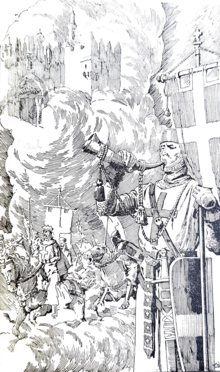User:Wenhongchi/Christianity in the Middle Ages

Crusades
[edit]The Crusades were a series of military conflicts conducted by Christian knights for the defense of Christians and for the expansion of Christian domains. Generally, the Crusades refer to the campaigns in the Holy Land sponsored by the papacy against invading Muslim forces. There were other crusades against Islamic forces in southern Spain, southern Italy, and Sicily, as well as the campaigns of Teutonic knights against pagan strongholds in Eastern Europe (see Northern Crusades). A few crusades such as the Fourth Crusade were waged within Christendom against groups that were considered heretical and schismatic (also see the Battle of the Ice and the Albigensian Crusade).

The Holy Land had been part of the Roman Empire, and thus Byzantine Empire, until the Islamic conquests of the seventh and eighth centuries. Thereafter, Christians had generally been permitted to visit the sacred places in the Holy Land until 1071, when the Seljuk Turks closed Christian pilgrimages and assailed the Byzantines, defeating them at the Battle of Manzikert. Emperor Alexius I asked for aid from Pope Urban II (1088–1099) for help against Islamic aggression. Urban II called upon the knights of Christendom in a speech made at the Council of Clermont on 27 November 1095, combining the idea of pilgrimage to the Holy Land with that of waging a holy war against the invading forces.
In the First Crusade leaded by Bohemond, after nine months of war of attrition, a traitor named Firuz led the Franks into the city of Antioch in 1098. However, less than a week, the might of an army numbering led by Kerbogah arrived and besieged the city. The crusaders reportedly had only 30,000 men and the Turks outnumbers them three to one; facing desertion and starvation, Bohemond was officially chosen to lead the crusader army in June 1098. On the morning of 28 June, the crusader army consisting of mostly dismounted knights and foot soldiers due to most horses had died at that point, sallied out to attack the Turks, which broke the line of Kerbogah's army, allowing the crusaders to gain complete control of the Antioch and its surroundings. [1] The Second Crusade occurred in 1145 when Edessa was retaken by Islamic forces. Jerusalem would be held until 1187 and the Third Crusade, famous for the battles between Richard the Lionheart and Saladin. The Fourth Crusade, begun by Innocent III in 1202, intended to retake the Holy Land but was soon subverted by Venetians who used the forces to sack the Christian city of Zara. Innocent excommunicated the Venetians and crusaders.[citation needed] Eventually the crusaders arrived in Constantinople, but due to strife which arose between them and the Byzantines,[citation needed] rather than proceed to the Holy Land the crusaders instead sacked Constantinople and other parts of Asia Minor effectively establishing the Latin Empire of Constantinople in Greece and Asia Minor. This was effectively the last crusade sponsored by the papacy; later crusades were sponsored by individuals. Thus, though Jerusalem was held for nearly a century and other strongholds in the Near East would remain in Christian possession much longer, the crusades in the Holy Land ultimately failed to establish permanent Christian kingdoms. The European's defeat can in no small part be attributed to the excellent marshal prowess of the Mameluke and Turks, who both utilized agile mounted archer and Greek fire in siege defense, however, ultimately it was the inability for the Crusader leaders to command coherently that doom the military campaign. In addition,the failure of the missioners to convert the Mongols to the Christianity thwarted the hope for a Tartar- Frank alliance; Mongols, later on converted to Islam.[2] Islamic expansion into Europe would renew and remain a threat for centuries culminating in the campaigns of Suleiman the Magnificent in the sixteenth century. On the other hand, the crusades in southern Spain, southern Italy, and Sicily eventually lead to the demise of Islamic power in the regions; the Teutonic knights expanded Christian domains in Eastern Europe, and the much less frequent crusades within Christendom, such as the Albigensian Crusade, achieved their goal of maintaining doctrinal unity.[3]
- ^ France, John. (1996). Victory in the East : a military history of the First Crusade. Cambridge Univ. Press. ISBN 0521419697. OCLC 258294189.
- ^ Beaumont, A. A.; Atiya, Aziz Suryal (1939-04). "The Crusade in the Later Middle Ages". The American Historical Review. 44 (3): 600. doi:10.2307/1839922. ISSN 0002-8762.
{{cite journal}}: Check date values in:|date=(help) - ^ For such an analysis, see Brian Tierney and Sidney Painter, Western Europe in the Middle Ages 300–1475. 6th ed. (McGraw-Hill 1998)
